All dogs can be good dogs, but these loveable breeds are among the friendliest, least-aggressive pups you can welcome into your home.
11 Least-Aggressive Dog Breeds That Make Friendly Family Pets
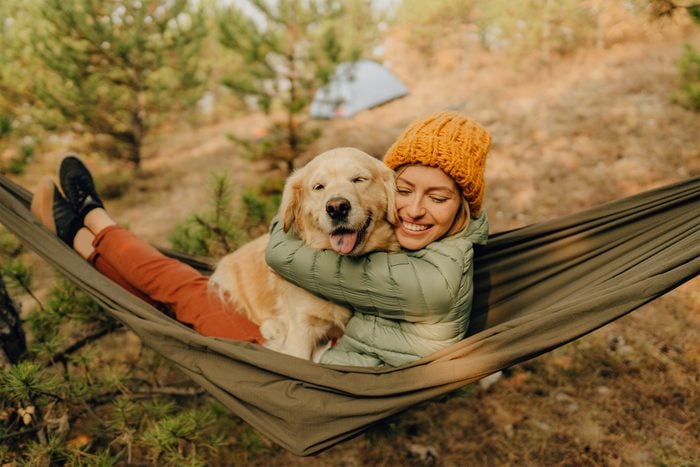
Is every dog a good dog?
As a lifelong dog lover, I’ve always had the attitude that every dog is a good dog. But admittedly, some dogs are more challenging than others, especially when it comes to things like house training, obedience training and aggression toward people or other animals. Any dog, even one of the most popular breeds, is capable of snarling, snapping or biting. But if you’re interested in adding a new four-legged friend to your family, you may want to look at dog breeds that are commonly considered less aggressive. We spoke to pet behavior experts Gina DiNardo of the American Kennel Club (AKC) and Katherine A. Houpt of Cornell University’s College of Veterinary Medicine to get their insights on the least-aggressive dog breeds.
“While certain breeds have predictable traits, a dog is still a dog, and there are no guarantees,” DiNardo says. If you’re adopting an adult dog with a past, its personal history will affect its behavior. And if a dog has been abused by humans or threatened or attacked by other dogs, its traumatic past may increase the odds of biting. Other things can factor into this equation, including boundaries you set (or don’t set) early on and individual circumstances in your home.
Still, some breeds deserve their reputation for being nonaggressive, upping the chances that your pooch will be too—as long as you put in some work. Ahead, find out which pups make the list of the least-aggressive dog breeds.
Get Reader’s Digest’s Read Up newsletter for more pets, humor, travel, tech and fun facts all week long.
About the experts
|
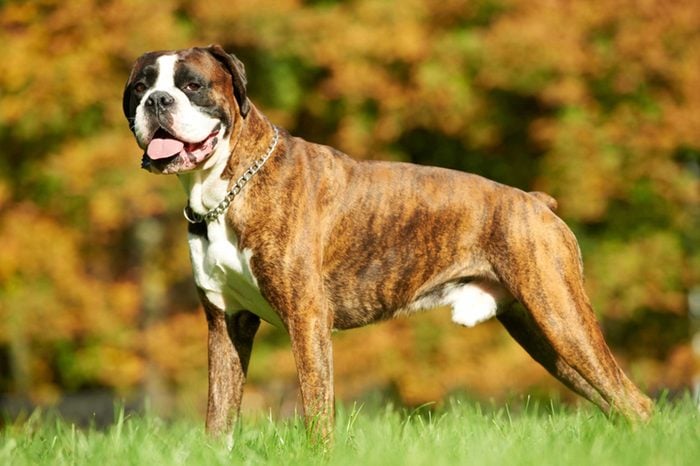
Boxer
Behind that big, slobbery muzzle and those broad shoulders (and the combative-sounding name!) is a big heart, especially when it comes to kids, says DiNardo. And that’s not all: Boxers are smart, trainable and loyal, she adds. They’re also playful, patient and protective, making them awesome BFFs for the littlest two-legged members of your family. Keep in mind that they grow up to be large dogs and need daily workouts to remain healthy and happy.
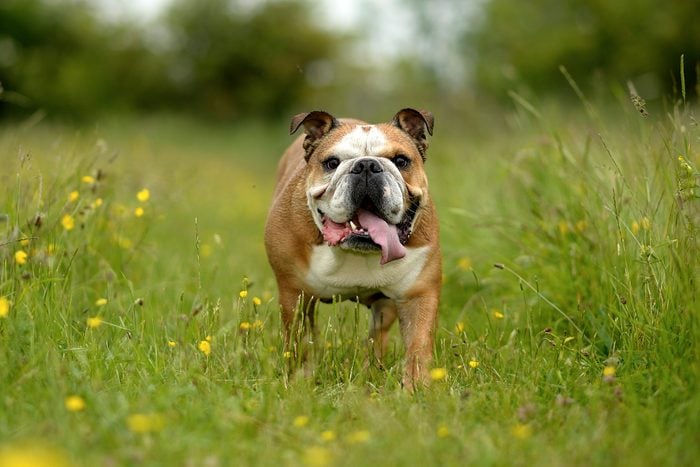
Bulldog
Here’s another ferocious-looking pooch with a tough-sounding name that’s really mellow. “This gentle breed is known for its lovable disposition,” says DiNardo. Those easygoing ways are the result of more than 100 years of breeding that turned the English bulldog from a fighter to a super-sweet companion, according to the AKC. But don’t confuse that laid-back nature with laziness: Your pup will still need at least one brisk walk daily.
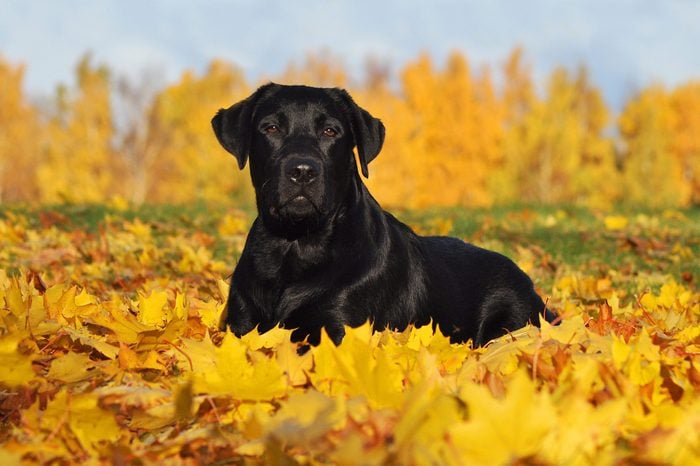
Labrador retriever
There’s a reason why these friendly pups are among the most popular in the United States. “They were bred to be cooperative when hunting and bringing ducks back to their owners,” says Dr. Houpt. Their eagerness to please makes them oh, so trainable, as do their smarts and even-tempered dispositions. Just remember, a bored dog can be a destructive one, so make sure these active pups stay stimulated with plenty of activity—like romps and games of fetch—to keep them fit and happy.
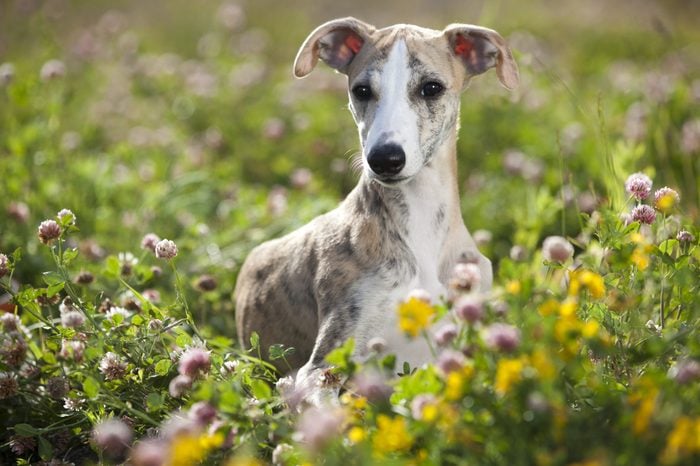
Whippet
When studying canine aggression, researchers from the University of Pennsylvania polled owners to find the least-aggressive breeds toward humans and dogs—and whippets led the list. These sleek hounds are calm, affectionate and mild-mannered, but do keep in mind that they have a high prey drive. They were bred as rabbit-chasers and need to be able to run in a fenced-in, critter-free area. After bursts of activity, whippets want nothing more than to chill in the company of their two-legged pals, according to the AKC.
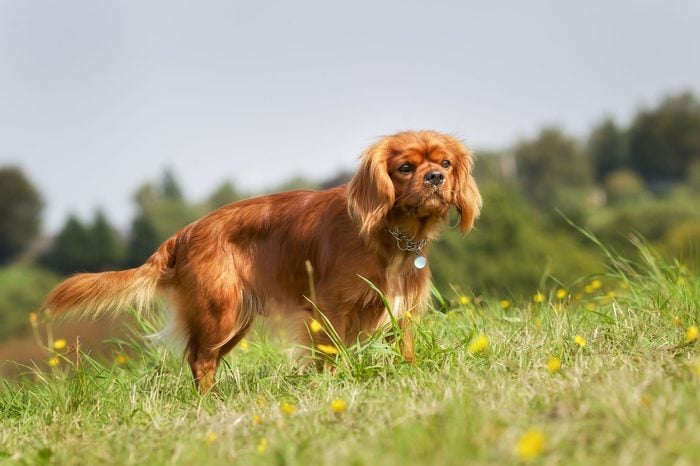
Cavalier King Charles spaniel
These toy spaniels are known for their cheerful natures and gentle dispositions (those adorable round eyes say it all), which makes them less likely to bite and also great with kids. “Cavalier King Charles Spaniels thrive when they’re part of a family,” says DiNardo. Another bonus: They’re very flexible in terms of what they want to do and tend to match their owners’ activity levels. So if you’re more energetic, your Cav will be happy to be out and about. Couch potato? After its daily walk, your pooch will be more than content to cuddle up beside you.
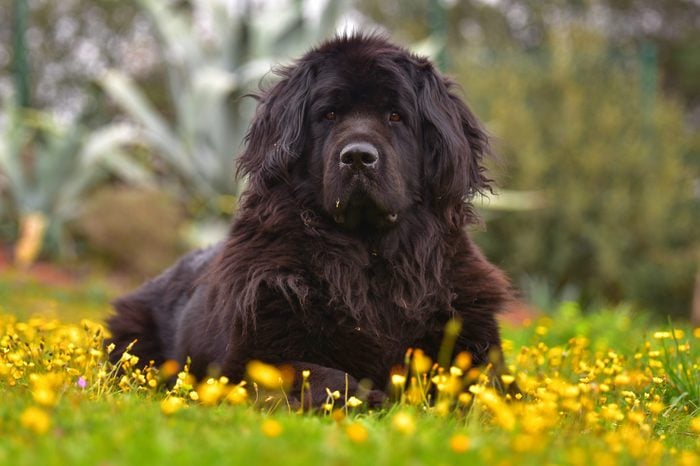
Newfoundland
The Darlings (of Peter Pan fame) were onto something when they picked Nana as their children’s nanny. Newfies are famous for their devoted natures and their affinity for kids, says DiNardo. In fact, one of the breed’s most distinctive characteristics is its gentle temperament. Be sure to give your lovable giant a chance to swim: These dogs were bred to save people from drowning, and they still like a good dog paddle as often as possible.
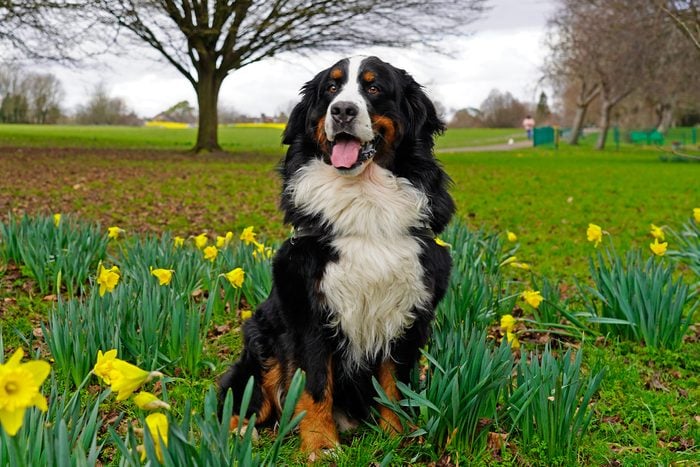
Bernese mountain dog
Yes, they’re big, powerful dogs, but they also tend to be placid. This is another breed that ranked very low on the scale of aggressive behaviors toward people and other pups, according to the University of Pennsylvania study. Berners are affectionate, bighearted, smart and eager to please, so they’re easy to train, according to the AKC. And if you’re not sold yet, you should know that they’re gentle with youngsters. Take them out on a long walk, and they’ll be happy to cart the kids—literally since pulling carts was one of the tasks this breed was originally used for!
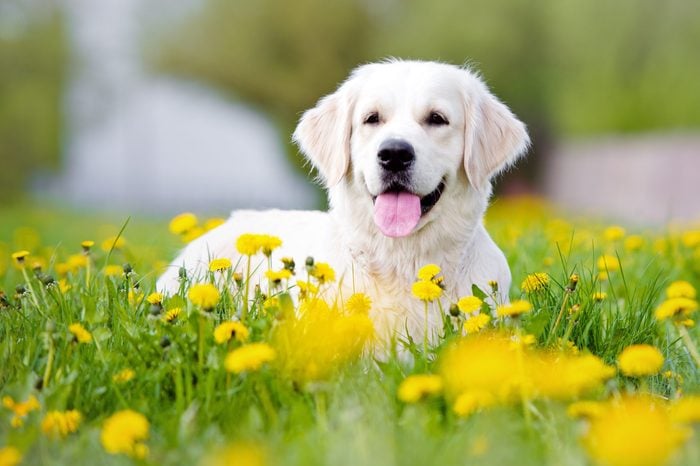
Golden retriever
Like Labs, goldens were bred to be obedient and less reactive hunting companions, says Dr. Houpt. This tends to make them less likely to snap, particularly at kids. They’re also eager to please and people-oriented, making them natural family sidekicks, DiNardo notes. But don’t be afraid to give your golden a job to do. These intelligent dogs are often used for search-and-rescue missions and as guide dogs for the blind, so they’re no strangers to work. And be sure to provide your pup with plenty of exercise.
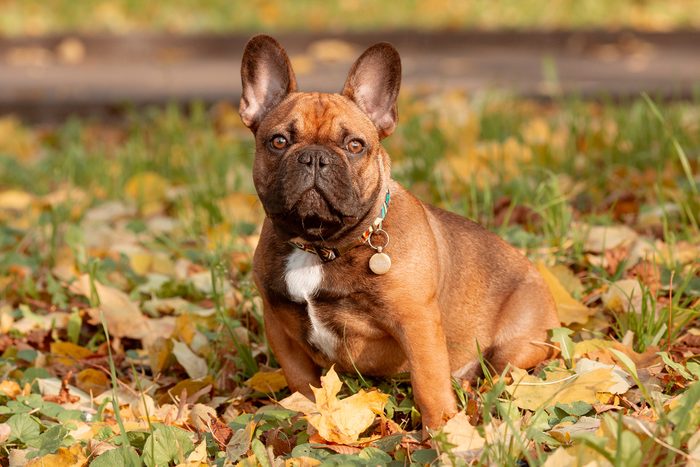
French bulldog
“Frenchies are affectionate, playful, smart, adaptable dogs,” says DiNardo. They get along well with just about everyone—two- and four-legged, young and old—so don’t be afraid to take your French bulldog out and about (use caution in hot weather, when it’s tough for these short-nosed dogs to breathe). These snuggle bugs need daily walks, but then they’re done, making them perfect apartment dwellers.
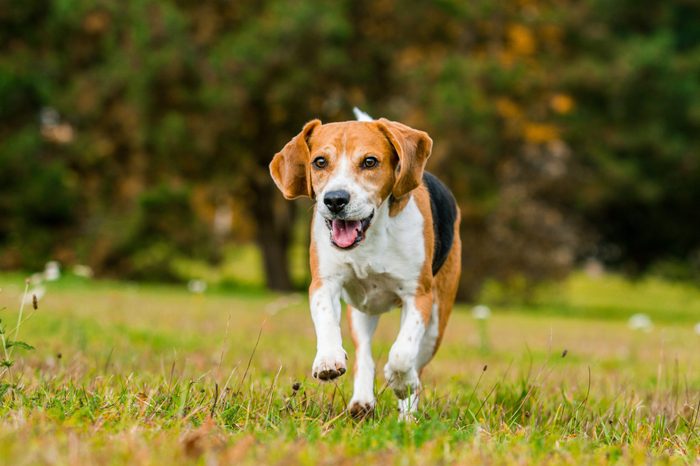
Beagle
These hounds were bred to live in packs (they’re hunting dogs, after all), so they do well with other pups and children, says DiNardo. What else makes them excellent playmates and furry family members, besides having such expressive faces framed by cute floppy ears? They’re happy-go-lucky and loving. They’re also curious and clever, so having a fenced-in yard is a must, as are on-leash walks. Beagles, which are known to be barky dogs, tend to be escape artists that take off after interesting scents, no matter where they lead.

Pug
“Pugs are totally devoted to their families,” says DiNardo, who adds that these cuties are also easygoing and even-tempered. So whether you’re a family of two or 10, have no other pets or a pack of dogs, live in the sticks or in a big city, your pug will probably adjust with no problem. Pugs love to curl up next to you, but they’re also playful—so give your pup a chance to burn off some calories with games or brisk walks. Need more pug cuteness? Check out these adorable pug mixes.
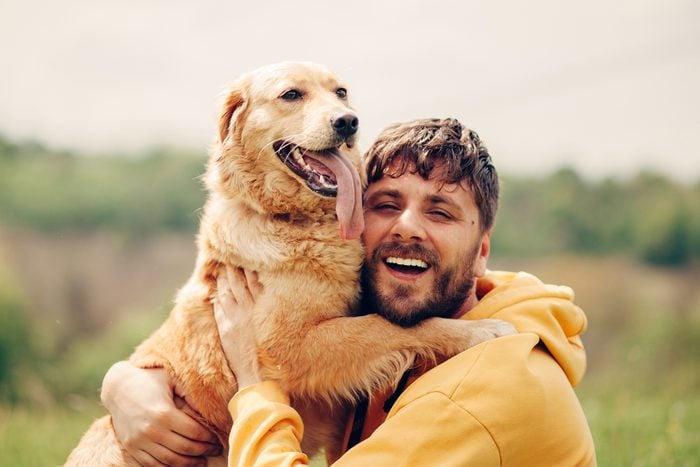
FAQS
How can you train a dog not to bite?
Dogs need to be socialized well to ensure they’re happy, confident and well-adjusted, says DiNardo. “That means your dog should become acclimated to all types of sights, sounds and smells in a positive manner,” she explains. To do this, it’s helpful to get your puppy before it’s 14 weeks old from a reputable breeder (not a puppy mill), says Dr. Houpt. Next, take your dog to a puppy kindergarten class and follow that up with an obedience class that stresses positive reinforcement.
If you want to adopt an older dog, you can find breed-specific rescue groups that will help you locate a purebred rescue and may even arrange for transport. And remember, your local animal shelter is probably filled with loving dogs of all ages and breeds.
How do you keep a dog from biting your kids?
“Interactions between your dog and kids should always be supervised, no matter what breed you own,” DiNardo says. Even the most well-adjusted dog could react poorly to being startled or scared when, say, your kids decide to hug her or play with her while she’s sleeping or eating.
The bottom line: Your dog is not the only one who needs to learn a few new tricks. It’s essential to teach children a few important rules, including how to be gentle, why you shouldn’t pull on tails or ears and when to back off when a dog clearly doesn’t want to play. Also, in the beginning, if you can’t supervise your human and furry children properly, make sure to put your pup in another room or in a crate so it doesn’t get overexcited and nip as children run around and play, suggests Dr. Houpt.
Why trust us
At Reader’s Digest, we’re committed to producing high-quality content by writers with expertise and experience in their field in consultation with relevant, qualified experts. For this piece, Linda Rodgers tapped her experience as a longtime journalist covering pet behavior, and then Caroline Coile, PhD, an award-winning journalist specializing in canine breeds, health and science, gave it a rigorous review to ensure that all information is accurate and offers the best possible advice to readers. For this piece, we relied on reputable primary sources, as well as our writer’s personal experience. We verified all facts and data and backed them with credible sourcing, and we will revisit them over time to ensure they remain accurate and up to date. Read more about our team, our contributors and our editorial policies.
Sources:
- Gina DiNardo, executive secretary of the American Kennel Club; interview January 2022
- Katherine A. Houpt, VMD, PhD, professor emeritus of behavior medicine at Cornell University’s College of Veterinary Medicine and author of Domestic Animal Behavior for Veterinarians and Animal Scientists; interview January 2022
- Applied Animal Behaviour Science: “Breed differences in canine aggression”





















